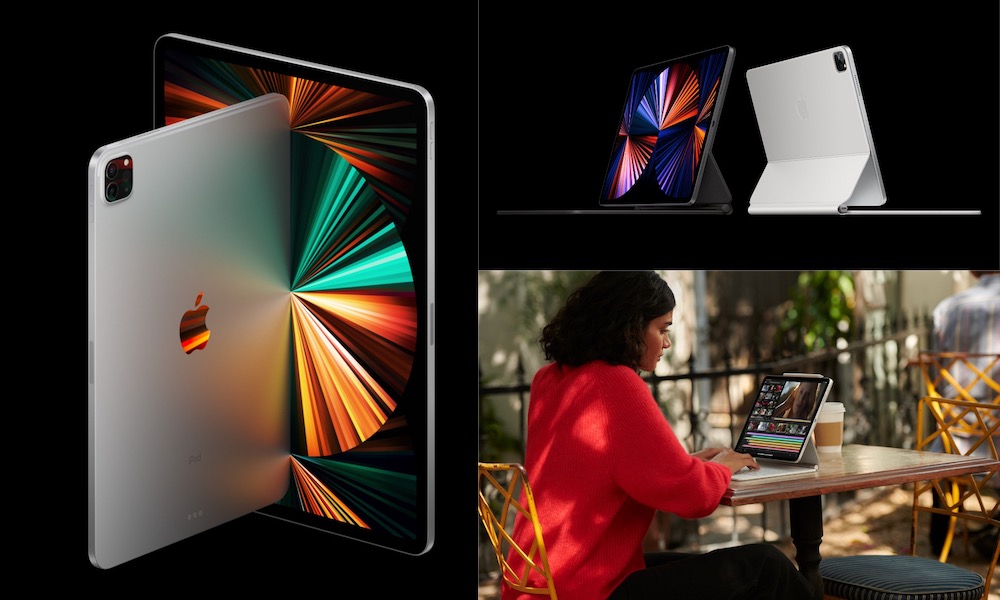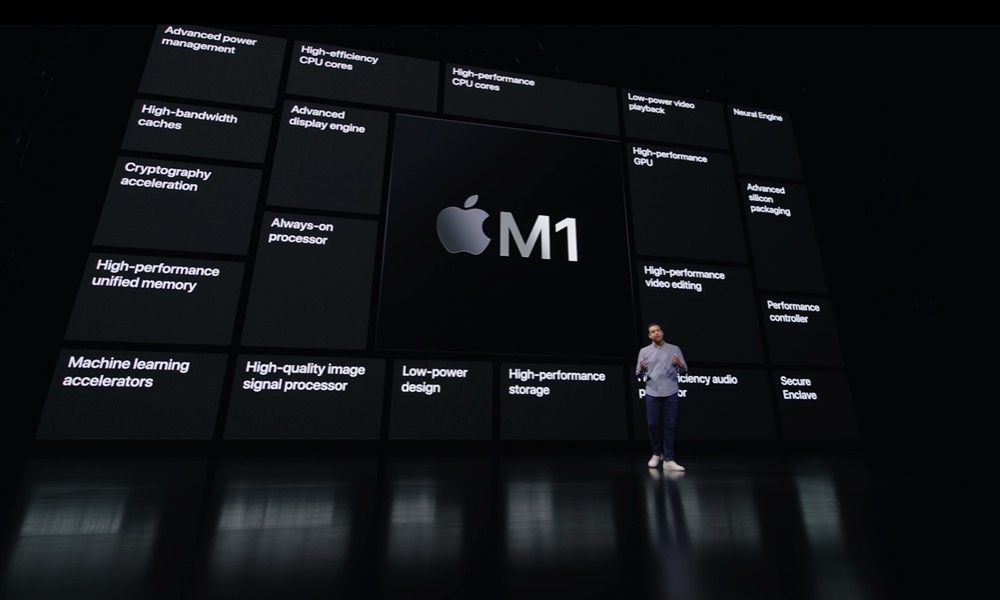Apple’s New Mini-LED iPad Pro Has Arrived with Retina Display XDR, 5G (and Even the M1 Chip)
 Credit: Apple
Credit: Apple
Toggle Dark Mode
We’ve known that a new iPad Pro lineup was coming for a while now, right down to details like the mini-LED display and the switch to a more powerful Thunderbolt port, but although Apple announced all of that at today’s Spring Loaded event, the company also threw us a giant curveball when it announced that it was packing its insanely powerful M1 chip into the new iPad Pro lineup.
While the new iPad Pro models were expected to get a pretty big chip upgrade in the form of an A14X chip — something that would probably have been on par with the M1 chip anyway — Apple’s choice to go straight to its Mac-based Apple Silicon made it more clear than ever that it’s putting the iPad Pro on the same level as its newest MacBook Air, MacBook Pro, Mac mini, and colourful new iMacs.
It’s a bold move in heralding exactly what the iPad Pro is all about, but it’s also fair to say that we’ve been on this road for a while. In fact, the writing was on the wall two years ago, when Apple switched the iPad Pro to USB-C ports, abandoning its treasured — and proprietary — Lightning technology in favour of providing the accessory compatibility that “pro” users needed.
Some believed that the move was simply the end of the Lightning port, but as Apple continued to keep USB-C exclusive to the iPad Pro, it became apparent that it wasn’t just switching ports — it was reserving those ports for its higher-end tablets to bridge the gap between traditional iPads and creative devices for hardcore professionals.
So, today’s move to the M1 chip is arguably the next big step in that road, and it’s as much about optics as it is about power. After all, Apple designed the M1 chip in the first place, so there’s no reason it couldn’t have made an A14X to rival it. Putting the actual M1 into the iPad Pro, however, is Apple saying flat-out that its most premium tablet is no longer a toy or a secondary tool, but rather a fully capable alternative to its more traditional Macs.
Apple hammered this point home in its segue into the iPad Pro portion of its event. After it finished announcing its new M1 iMac and once again praising the merits of the M1 chip, it added that “It’s not just Mac users who want to get their hands on it,” and moved to a video intermission that showed somebody invading Apple HQ, Mission Impossible-style, and stealing the M1 chip out of a MacBook Air.
At first glance, we were wondering if this was going to be a friendly dig at Intel, who we’re sure would also love to get their hands on Apple’s M1 chip designs, but instead the secret agent pulled off his mask to reveal none other than Apple CEO Tim Cook, who dropped the M1 chip into a new iPad Pro.
Enter the 2021 iPad Pro
The virtual stage was then handed over to Raja Bose of Apple’s iPad Product Marketing department, who proceeded to explain how much of a massive jump in performance the M1 is going to bring to the iPad Pro.
While all of Bose’s comparisons were to the original 2010 iPad, they did help to make the point: 75 times faster CPU performance, 1500 times faster graphics. It was a comparison clearly intended to drive home exactly how far Apple’s tablet has come from its infancy when many tech pundits criticized it as merely a device for “consumption” rather than “creation.”
In addition to all the incredible performance gains, the M1 chip also brings two other Mac-style enhancements to the iPad Pro: Significantly faster storage access, likely thanks to its NVMe storage architecture that’s designed for handling high-performance SSDs, and Thunderbolt and USB 4 support.
The addition of the Thunderbolt port to the iPad Pro will offer up the kind of super-fast data transfers and high-end accessory compatibility that’s needed by serious photographers and videographers. During a video shown after the initial presentation, a Photoshop and Lightroom developer praised the improvement as allowing creative professionals to suck in data from cameras and SD cards in a way that simply wasn’t possible before.
To go along with this, Apple is also offering up the iPad Pro in a 2TB version for the first time ever — a staggering amount of storage for the tablet that will offer enough room for 60,000 ProRAW photos, or 1,200 hours of Dolby Vision HDR 4K video.
It wasn’t necessarily a sure thing, but we were less surprised to find that Apple is indeed adding 5G to the cellular models of the new iPad Pro as well. Having already debuted the technology on the iPhone 12, the specs aren’t much of a surprise, although Apple will be selling mmWave-capable versions in the U.S., and is promising the same “up to 4Gbps” speeds on compatible carrier networks.
Liquid Retina XDR
As expected, the new 12.9-inch iPad Pro gains the mini-LED technology we’ve been hearing about since last year, although of course Apple isn’t calling it that. Instead, it’s the new Liquid Retina XDR.
In fact, except when Heidi Delgado, Apple’s Senior Director of Program Management for Imaging and Sensing Technologies, took the stage to explain the technology, Apple barely mentioned mini-LED at all. Delgado referred to “an array of LEDs that are incredibly small,” and dropped the word “mini” a couple of times, when describing the 10,000 LEDs that make up the 12.9-inch screen (a massive jump from the 72 LEDs found on the previous iPad Pro), but clearly Apple wants us to focus on the results, and not the technology.
Instead, Apple drew comparisons to its $5,000 Pro Display XDR that was released two years ago alongside its new Mac Pro. In fact, Bose went so far as to call it “stunning Pro Display XDR performance on the 12.9-inch iPad Pro.”
The results are impressive, however, with Apple promising a 1,000,000:1 contrast ratio typically found only on OLED displays, along with 1,000 nits of full-screen brightness and 1,600 nits peak brightness. All of this in a display that fits into a 6.4mm thickness, weighs only 1.5 pounds, and still delivers all-day battery life.
Of course, as impressive as this is, it’s another move that makes it clear that Apple is targeting serious professionals, highlight how it will provide true-to-live editing of HDR content, even allowing filmmakers to review and approve Dolby Vision HDR video footage. That said, it will be great simply for watching movies and other video content too, especially when combined with the Dolby Atmos sound system.
Unfortunately, this is a move exclusively for users of the larger 12.9-inch iPad Pro, which is exactly what we were expecting. While the 11-inch iPad Pro still gains the M1 chip with all of its powerful features, along with the Thunderbolt port and 5G capabilities, the display on that one will remain the older style Liquid Retina LCD. It’s still a great display, but it’s clear that it can’t hold a candle to what Apple has accomplished in the 12.9-inch iPad Pro.
Since we’re talking about packing in 10,000 mini-LEDs into a 12.9-inch screen, however, our guess is that Apple just hasn’t been able to miniaturize it enough to make it work on a smaller screen — at least not in a way that it’s satisfied with. In fact, it’s an open question right now whether that will ever be achievable, and some have suggested that mini-LED is just a stepping stone on the way to better OLED screens for the iPad Pro.
Center Stage
Apple had one more small surprise up its sleeve for its new iPad Pros, however, with the first-ever major expansion of its front TrueDepth Camera system.
Taking the virtual stage, Fiona O’Leary one of Apple’s imaging and sensing technology designers, outlined the camera improvements on the new iPad Pro, and while the rear cameras will benefit from the more powerful image signal processor in the M1 chip, it’s the front TrueDepth Camera that’s taking a bigger leap, with the addition of a 12MP ultra-wide lens.
The purpose of this isn’t just to capture a wider field of view, however, but rather to power a new feature that Apple is calling “Center Stage.” New machine learning algorithms will allow the iPad Pro to “follow” you around the room, displaying a standard front camera field of view while using the ultra-wide angle to figure out exactly where you are and ensure that you’re always in the centre of the frame, panning as necessary, and even adjusting when other people enter the shot.
Additionally, it looks like the new iPad Pro will also expand the use of the LiDAR Scanner to handle low-light photography, in much the same way that it already does on the iPhone 12. While the LiDAR Scanner first came to the 2020 iPad Pro last year, it was previously limited to augmented reality applications.
When’s It Coming
The 2021 iPad Pro will start at $799 in 128GB Wi-Fi only configurations for the 11-inch model and $1,099 for the 12.9-inch Liquid Retina XDR version. Cellular models will come in at around $200 more in each configuration, with the 2TB Wi-Fi + Cellular models topping out at $2,099 and $2,399, respectively. That means you can now pay more for an iPad Pro than a fairly high-end MacBook Pro.
Although previous reports suggested that the 12.9-inch iPad Pro could be released later than the 11-inch version due to a shortage of mini-LED display components, it seems that Apple is planning on releasing both at the same time, although so far, it’s only offering up “the second half of May,” for the availability, rather than a specific date. You will, however, be able to preorder both models on April 30th.












